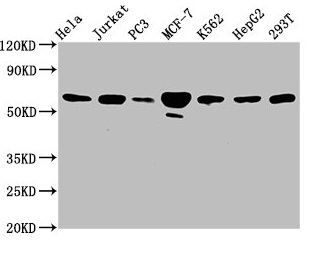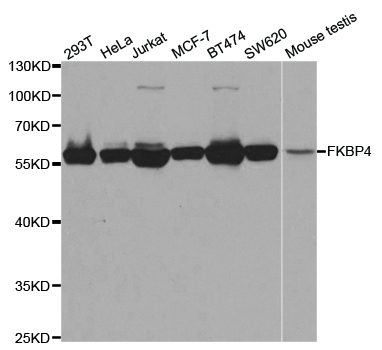FKBP52 Antibody (OASE00056)
OASE00056
ApplicationsImmunoFluorescence, ImmunoPrecipitation, Western Blot, ImmunoCytoChemistry, ImmunoHistoChemistry
Product group Antibodies
TargetFKBP4
Overview
- SupplierAviva Systems Biology
- Product NameFKBP52 Antibody (OASE00056)
- Delivery Days Customer23
- ApplicationsImmunoFluorescence, ImmunoPrecipitation, Western Blot, ImmunoCytoChemistry, ImmunoHistoChemistry
- CertificationResearch Use Only
- ClonalityMonoclonal
- Clone IDHi52C
- Concentration1 mg/ml
- ConjugateUnconjugated
- Gene ID2288
- Target nameFKBP4
- Target descriptionFKBP prolyl isomerase 4
- Target synonymsFKBP51, FKBP52, FKBP59, HBI, Hsp56, PPIase, p52, peptidyl-prolyl cis-trans isomerase FKBP4, FK506 binding protein 4, 59kDa, HSP binding immunophilin, T-cell FK506-binding protein, 59kD, peptidylprolyl cis-trans isomerase, rotamase
- HostMouse
- IsotypeIgG2a
- Scientific DescriptionHSP90 is crucial to cellular signaling by its regulation of the folding, activity, and stability of a wide range of client proteins. These client protein complexes may also contain one or more cochaperones (1). One class of HSP90-binding cochaperone is composed of proteins with a characteristic tetratricopeptide repeat (TPR) domain that forms an HSP90 binding site. Among the TPR cochaperones of HSP90 are Hop/Sti1, protein phosphatase PP5, and members of both the FK506- and cyclosporin A-binding families of immunophilins (2). FK506-binding protein 51 (FKBP51) and FKBP52 are large molecular weight immunophilins that are part of the mature glucocorticoid receptor (GR) heterocomplex (3). The N terminal domain of each protein binds FK506 and has peptidyl-prolyl isomerase (PPIase) activity that converts prolyl peptide bonds within target proteins from cis- to trans- proline. The C-terminal domains contain the TPR repeats involved in protein-protein interactions with the HSP90 (4). Although FKBP52 and FKBP51 share ~75% sequence similarity, they affect hormone binding by glucocorticoid receptor in opposing manners and have different HSP90-binding characteristics (3). FK506 binding protein 51 kDa (FKBP51 or otherwise referred to as FKBP54) has been identified as a progestininducible gene. This protein is predominantly expressed in murine T cells but in humans, it is abundantly expressed in numerous tissues at levels many times higher than FKBP12. The FKBP51 gene is known to be induced by glucocorticoids (5).
- Storage Instruction-20°C
- UNSPSC12352203






